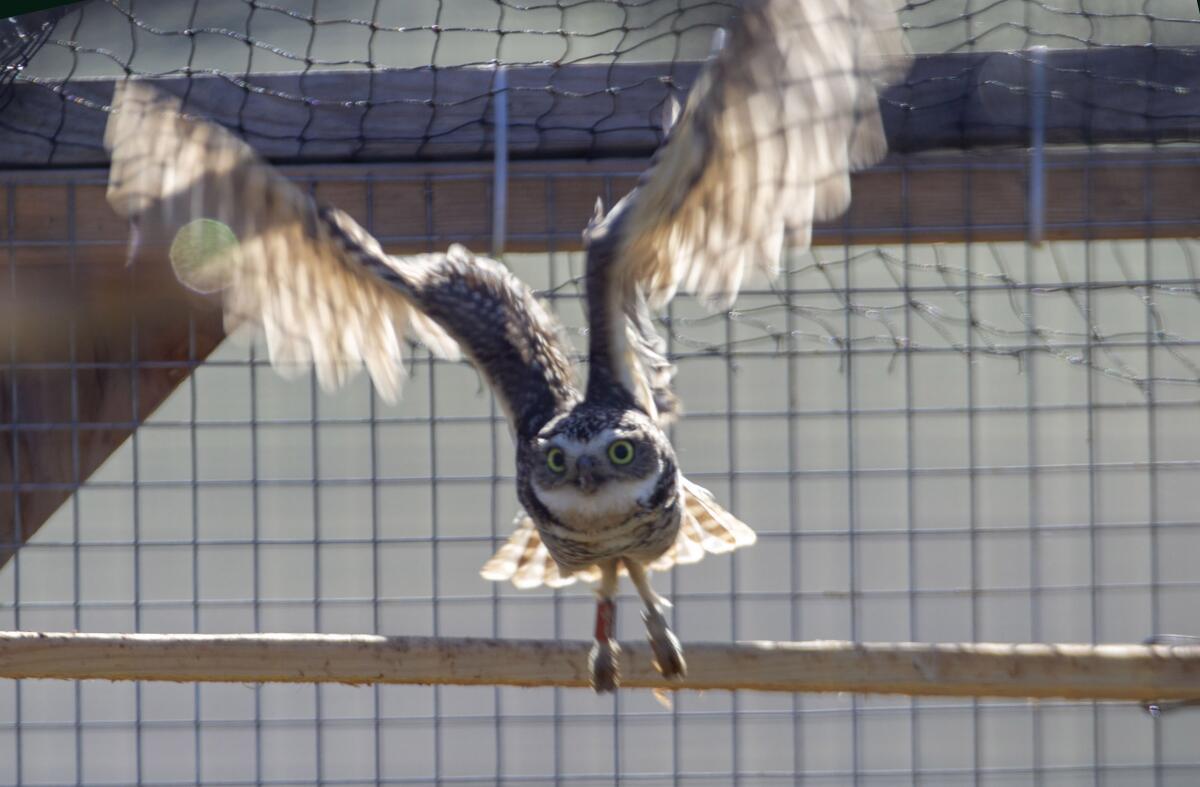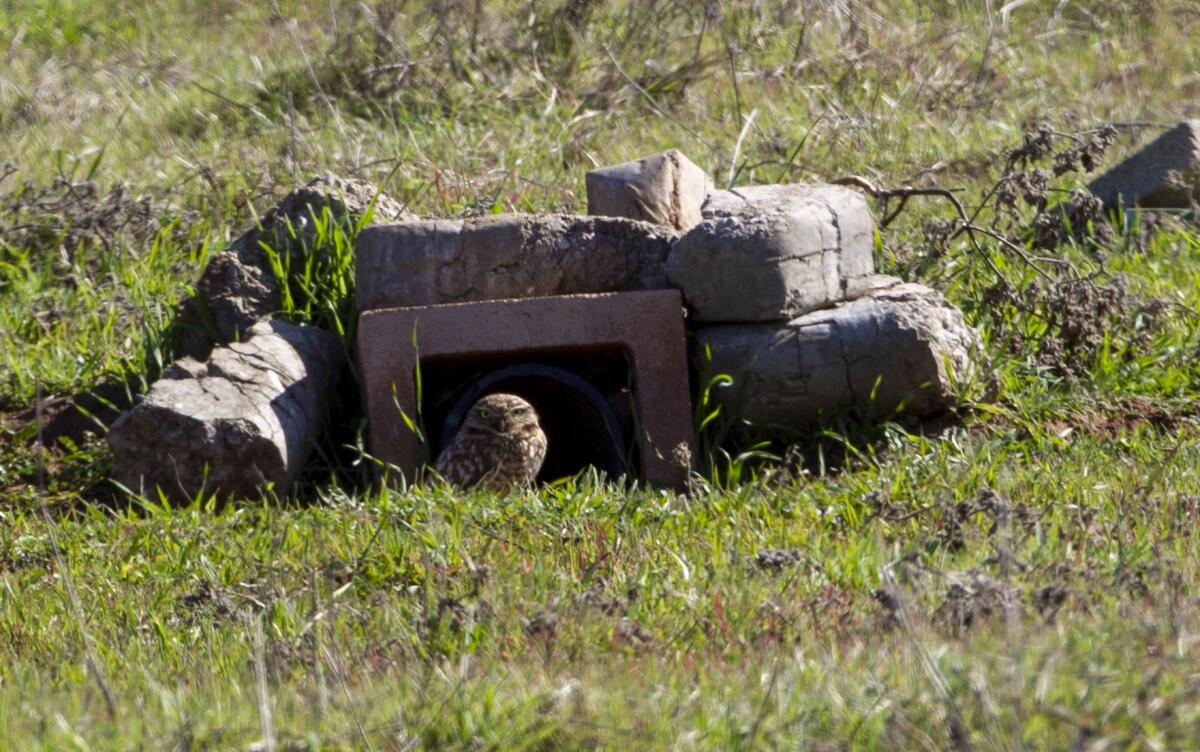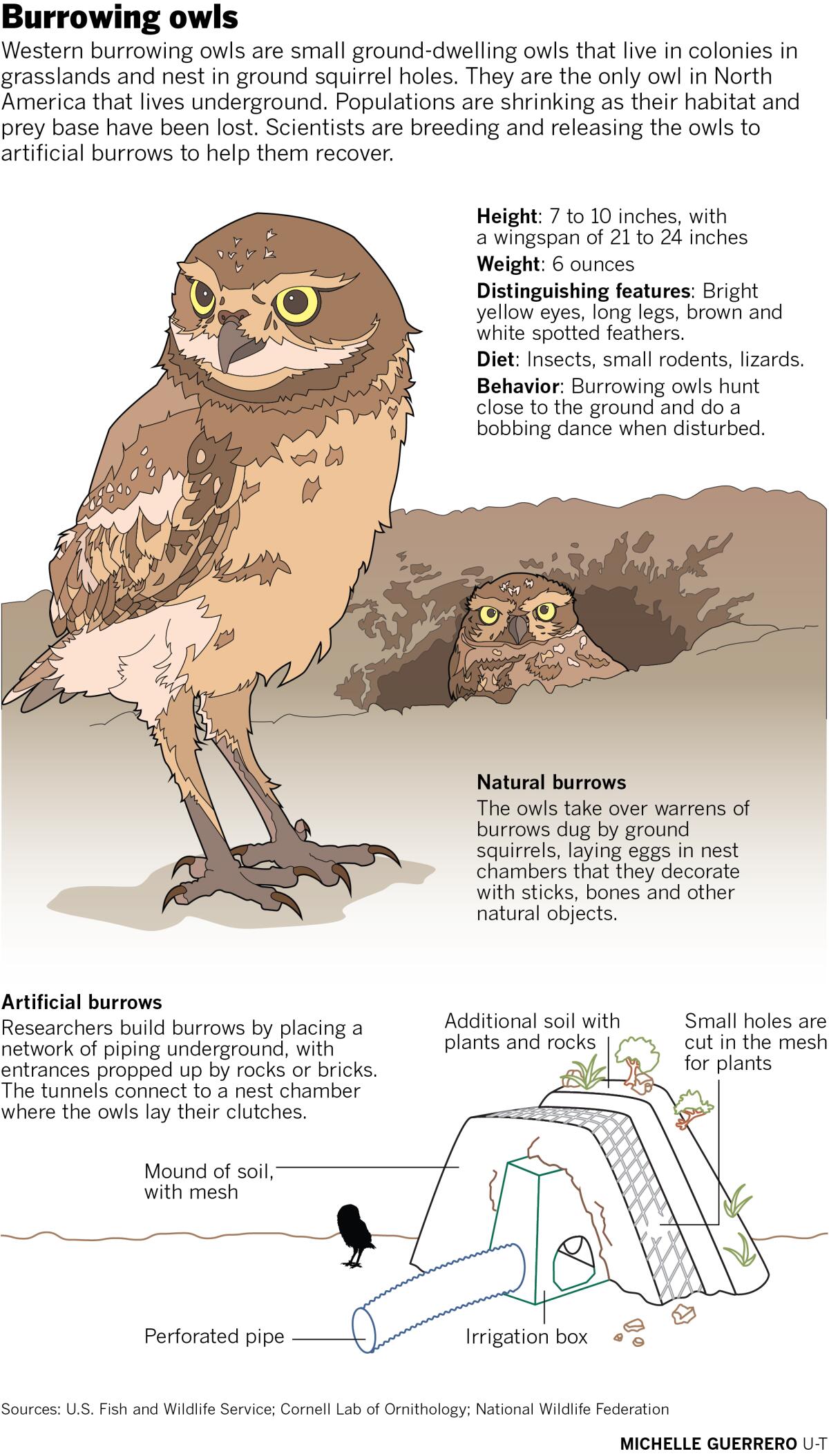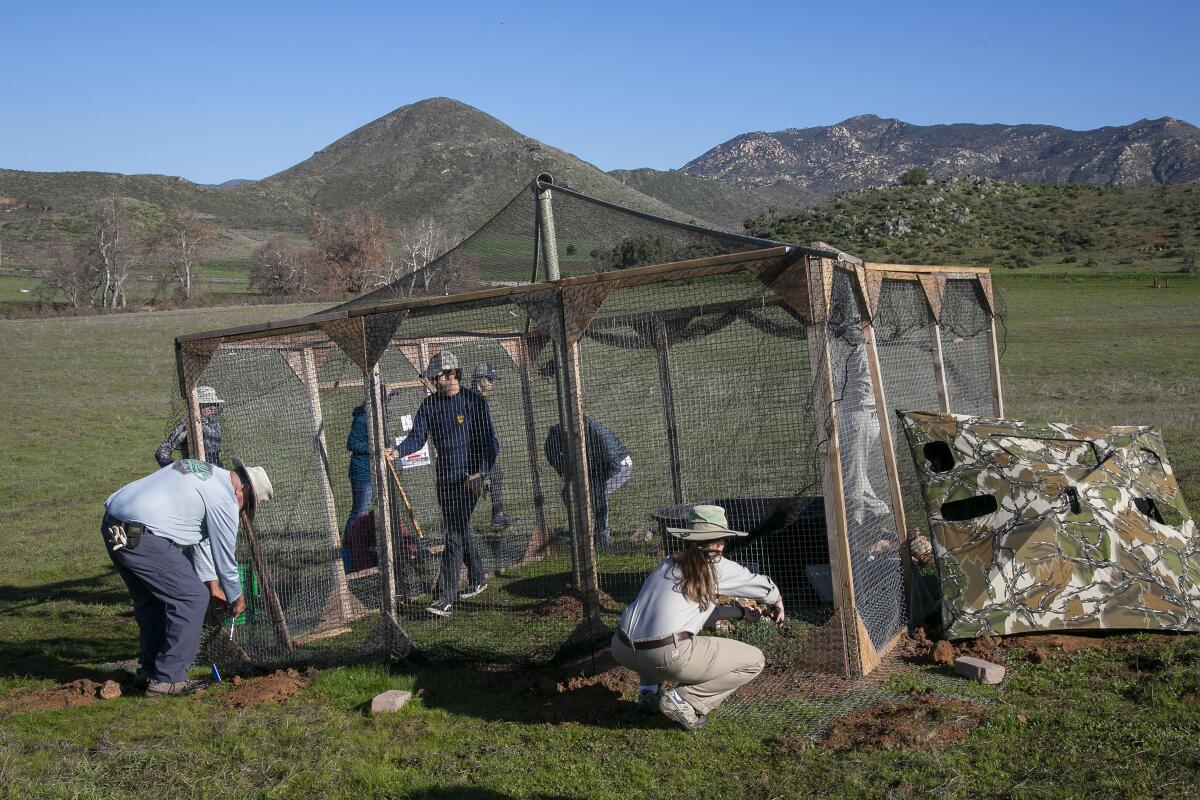Young burrowing owls get a shot at survival in San Diego

JAMUL, Calif. — At a field in Jamul, a little owl stood sentry beside a pile of rocks, surveying the landscape with luminous, yellow eyes.
The burrowing owl was guarding the tunnels that form its nesting space in the East County grasslands. But in the larger picture, it was standing its ground against threats of habitat loss and population decline.
The bird is part of a program to return the small, long-legged owls to grasslands where they used to live. The San Diego Zoo Institute for Conservation Research, working with natural resource agencies, has bred the owls in captivity and is slowly establishing new colonies to secure their survival. Last month, researchers released eight young owls to Rancho Jamul Ecological Reserve in hopes they will stay and breed there, expanding the fledgling colony.
“Historically, there were small, local populations all up and down the coast of California and in every grassland,” said Sarah Hennessy, a researcher in recovery ecology with the zoo. “Those are the areas that have been developed. So those populations are blinking out, one by one.”
To counter that, scientists have constructed artificial burrows in suitable areas, using a series of underground pipes with an entrance propped up by rocks. The tunnels are connected to a nesting chamber where the owls can safely incubate and rear their young. Those structures improve burrowing owl habitat, but with populations plunging, zoo researchers began captive breeding to reestablish owl colonies throughout San Diego.
“Wouldn’t it be great if we had stable populations throughout the county?” Hennessy asked. “We are working toward that long-term goal.”
Burrowing owls are the only North American owl species to nest underground, taking over tunnels dug by ground squirrels. At just 7 to 10 inches tall, they’re curiously long-legged, with brown and cream feathers and eyes like wide, lemon moons. They’re adaptable, but are struggling to survive amid urban development and other sweeping habitat changes.

In 2018, researchers captured two pairs of breeding owls who were displaced from their territory by construction, and brought them to the San Diego Zoo Safari Park in Escondido, said Kristina Heston, animal care supervisor for the bird department. The owl pairs live in enclosures, with nesting chambers equipped with remote cameras so zoo staff can track their young. Once the chicks get older, they’re moved to a larger aviary to learn to fly, hunt and watch for predators, such as the hawks that sometimes swoop over the enclosed space.
Each pair produced eggs, and two of their offspring were released to Rancho Jamul last year, where one of them found a mate and started her own family. The original pairs, plus an additional breeding pair, recently hatched 18 more chicks, which are being introduced to the reserve as well. The first batch was released in January, and the remaining owls will be set free this month.
The goal, Hennessy said, is to develop a series of breeding colonies, or “recovery nodes,” throughout San Diego, which would include sufficient numbers and genetic diversity to restore healthy populations. They don’t have a target number of breeding colonies or individuals, but say they plan to release owls at a second site in the near future.
“This is a security measure, not having all our owls in one basket,” said Susanne Marczak, senior research coordinator in recovery ecology for San Diego Zoo Global.

On the release date last month, researchers gathered early at Rancho Jamul, where the owls had been acclimating to their new environment for several weeks. They planned to release eight owls, including six that were born and bred at the San Diego Zoo Safari Park and were getting their first taste of the wild. Two others were found lost in downtown San Diego and rescued by staff with Project Wildlife, then rehabilitated at zoo facilities.
Weeks earlier, the animals were placed in artificial burrows covered by temporary flight enclosures. That way they became familiar with the sights, sounds and smells of the reserve while still partially contained, and have a better likelihood of remaining at the site.
Several of the young owls were flying about the enclosures or perched in corners when the team arrived. Researchers placed them in the underground burrows and then disassembled the chicken-wire and wood structures, so the owls could venture out when they felt ready.
“We will take down the flight enclosures, so these owls can truly be free and figure out life,” Marczak said.
Western burrowing owls used to be common in San Diego and other parts of California, and can live comfortably close to humans wherever there’s sufficient open space: on airports, golf courses and farm fields. However, urban development has displaced much of the flat, open ground they use, leaving disconnected patches of land. The fragmented habitat separates remaining owl colonies, leaving them isolated, with limited opportunities to breed.
Moreover, these are birds that prey on mice and insects, and rely on ground squirrels for burrows. Those animals are disdained as nuisances, so rodent-control efforts and insecticides have eradicated much of the owls’ prey base, along with the squirrels that dig their dens. And the pesticides used sometimes poison burrowing owls as well. Vehicle strikes also claim some of the low-flying birds. And domestic predators such as dogs and cats also threaten burrowing owls, as do wild animals such as ravens, skunks and coyotes, which are unnaturally abundant on the edges of urban areas.
Within Southern California, burrowing owls are most numerous in Imperial County, particularly around the Salton Sea, in agricultural fields and along drainage canals.
“It’s sort of like an artificial oasis for burrowing owls,” Marczak said.
Owl numbers have plunged there too, however, as the area has undergone land-use changes and water transfers. Surveys by the Imperial Irrigation District showed the burrowing owl population dropped from about 5,600 pairs in the early 1990s to 4,879 pairs in 2007 and 3,557 pairs in 2008, according to a 2010 story in the Los Angeles Times.
In San Diego County, their status is much worse. Most of those are in the Otay Mesa area, where housing development, border wall construction and other pressures are compromising their habitat, researchers said. Zoo researchers said they don’t have current populations for the state or the Southern California region, but Hennessy estimated there are just 75 breeding pairs in San Diego County. That’s far too low to sustain their populations here.
“Burrowing owls are on life-support in San Diego and this active intervention by conservation organizations is necessary to restore the population,” said Jonathan Evans, Environmental Health Legal Director for the Center for Biological Diversity, which has monitored and advocated for burrowing owls.
Although they’re designated as a species of special concern in California, they aren’t listed as threatened or endangered under either the state or federal Endangered Species Acts. The Center for Biological Diversity petitioned for a California listing for burrowing owls in 2003, but that was rejected by the California Department of Fish and Wildlife, Evans said.
As a species of special concern, they’re kept on closer watch than other, more abundant animals, but don’t receive the extensive protections and recovery efforts that threatened or endangered species do. Evans said the captive breeding and reintroduction efforts are important, but habitat conservation and other protections are needed to sustain the new colonies and remaining wild-born owls.
“It’s a stop-gap measure to help reverse the trend of population loss, but we need to address the underlying issues, and deal with the long-term threats to the burrowing owl populations,” he said.
At Rancho Jamul, the zoo team was eager to take a first step toward restoring burrowing owl populations, as they introduced eight young owls to the reserve. They removed the enclosures, and then fitted camera traps in the nesting chambers so they can observe their clutches, and then intervene if the eggs aren’t fertile, or don’t hatch. If that happens, zoo staff can remove the failed eggs, giving the owls another chance to breed that season.

From now until August, they’ll feed the animals a mix of rodents and live insects three times weekly, and observe whether they’re learning to fend for themselves. Owl pellets form little regurgitated records of their diet, with bones, fur, insect exoskeletons and other indigestible materials coughed up intact. Since the lab mice that staff feed the owls are white, researchers can distinguish those from mice or other rodents that they catch on their own.
The zoo scientists said they’re encouraged by the owls’ breeding success at Safari Park, and at the earlier female’s ability to assimilate to the wild colony.
“Hitting all these success milestones is an affirmation that the steps we’re taking are working,” Marczak said.
After the team took down the enclosures and opened the burrows, they waited. All that remained was for the owls to emerge and claim their place in the wild.
Brennan writes for the San Diego Union-Tribune.
More to Read
Sign up for Essential California
The most important California stories and recommendations in your inbox every morning.
You may occasionally receive promotional content from the Los Angeles Times.











